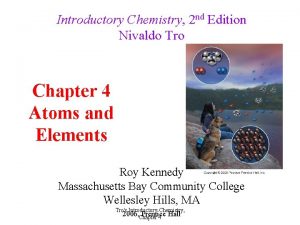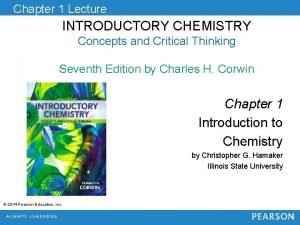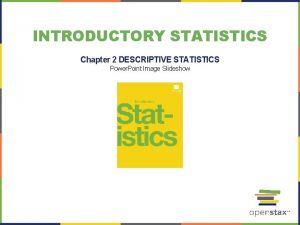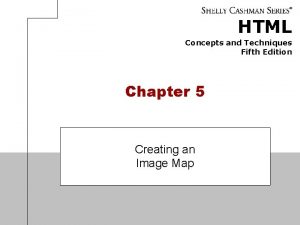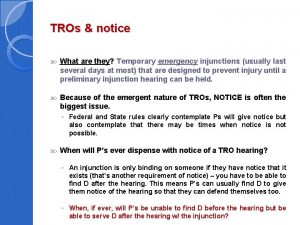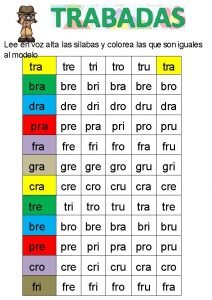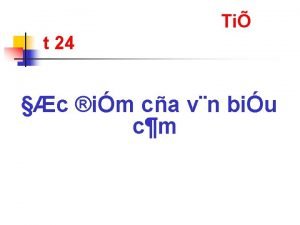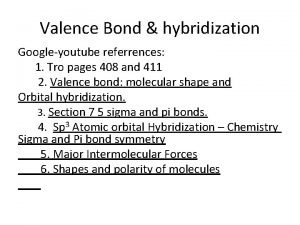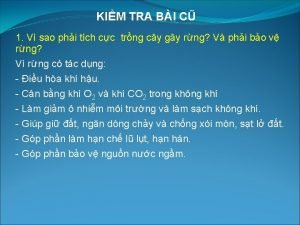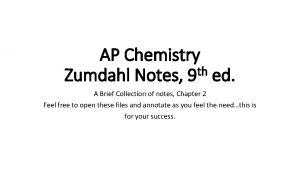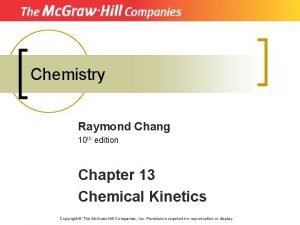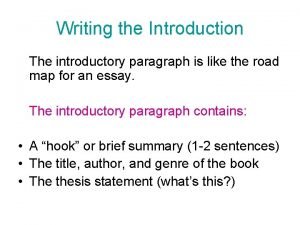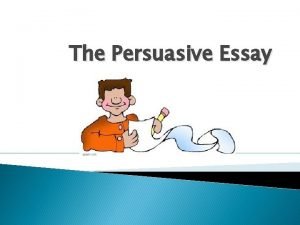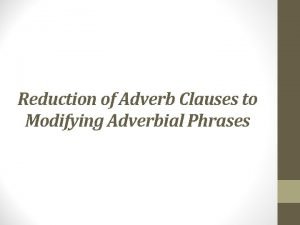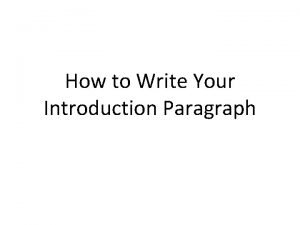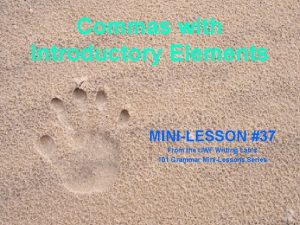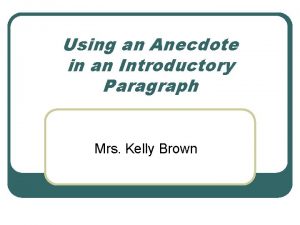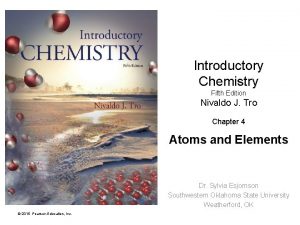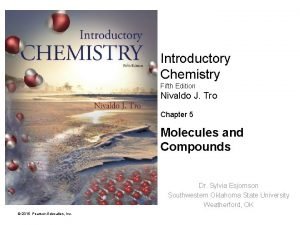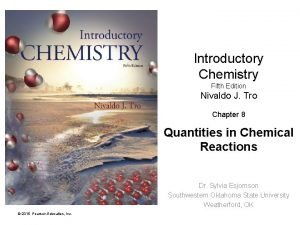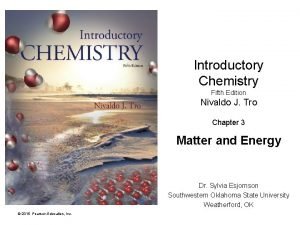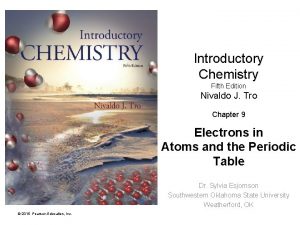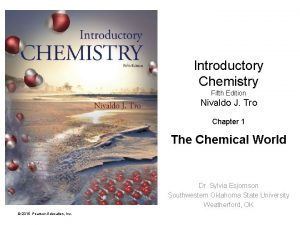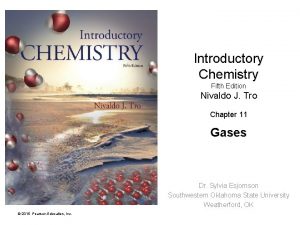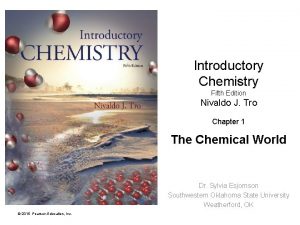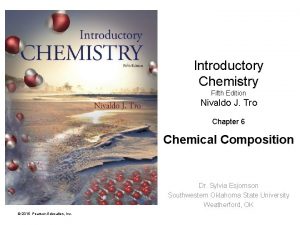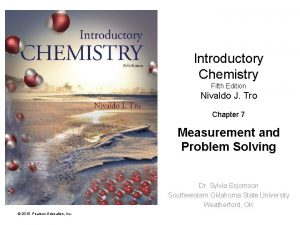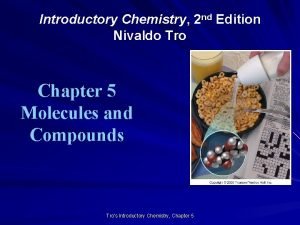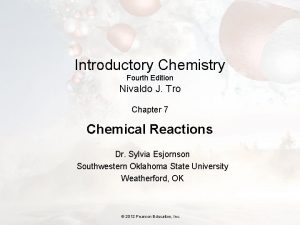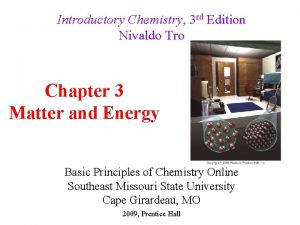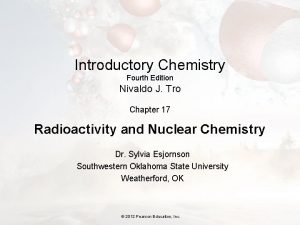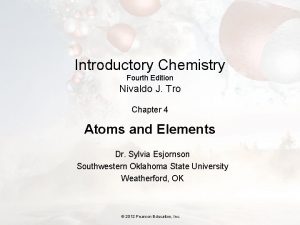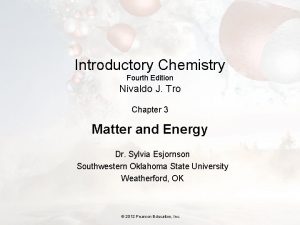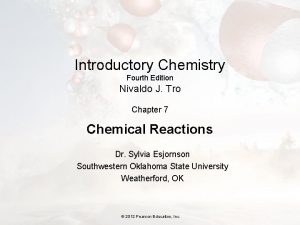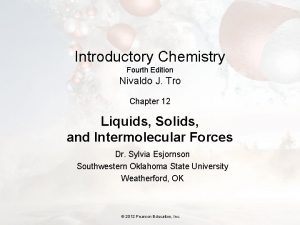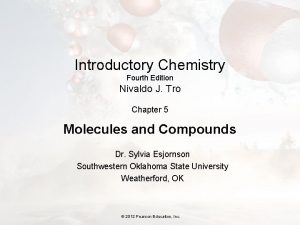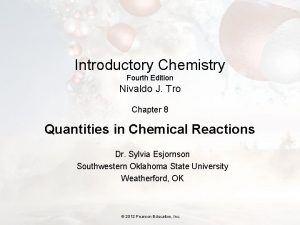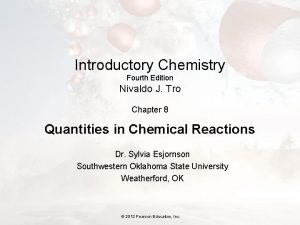Introductory Chemistry Fifth Edition Nivaldo J Tro Chapter












































































- Slides: 76

Introductory Chemistry Fifth Edition Nivaldo J. Tro Chapter 8 Quantities in Chemical Reactions Dr. Sylvia Esjornson Southwestern Oklahoma State University Weatherford, OK © 2015 Pearson Education, Inc.

Global Warming: Too Much Carbon Dioxide • The combustion of fossil fuels such as octane (shown here) produces water and carbon dioxide as products. • Carbon dioxide is a greenhouse gas that is believed to be responsible for global warming. © 2015 Pearson Education, Inc.

The Greenhouse Effect • Greenhouse gases act like glass in a greenhouse, allowing visible-light energy to enter the atmosphere but preventing heat energy from escaping. • Outgoing heat is trapped by greenhouse gases such as CO 2. © 2015 Pearson Education, Inc.

Combustion of Fossil Fuels Produces CO 2 • Consider the combustion of octane (C 8 H 18), a component of gasoline: 2 C 8 H 18(l) + 25 O 2(g) 16 CO 2(g) + 18 H 2 O(g) • The balanced chemical equation shows that 16 mol of CO 2 are produced for every 2 mol of octane burned. © 2015 Pearson Education, Inc.

Combustion of Fossil Fuels Produces CO 2 • Since we know the world’s annual fossil fuel consumption, we can estimate the world’s annual CO 2 production using the balanced chemical equation. • Calculation shows that the world’s annual CO 2 production—from fossil fuel combustion—matches the measured annual atmospheric CO 2 increase, implying that fossil fuel combustion is indeed responsible for increased atmospheric CO 2 levels. © 2015 Pearson Education, Inc.

Stoichiometry: Relationships between Ingredients • The numerical relationship between chemical quantities in a balanced chemical equation is called reaction stoichiometry. • We can predict the amounts of products that form in a chemical reaction based on the amounts of reactants. • We can predict how much of the reactants are necessary to form a given amount of product. • We can predict how much of one reactant is required to completely react with another reactant. © 2015 Pearson Education, Inc.

Making Pancakes: Relationships between Ingredients • A recipe gives numerical relationships between the ingredients and the number of pancakes. © 2015 Pearson Education, Inc.

Making Pancakes: Relationships between Ingredients • The recipe shows the numerical relationships between the pancake ingredients. • If we have 2 eggs—and enough of everything else —we can make 5 pancakes. • We can write this relationship as a ratio. • 2 eggs: 5 pancakes © 2015 Pearson Education, Inc.

What if we have 8 eggs? Assuming that we have enough of everything else, how many pancakes can we make? © 2015 Pearson Education, Inc.

Making Molecules: Mole-to-Mole Conversions • In a balanced chemical equation, we have a “recipe” for how reactants combine to form products. • The following equation shows how hydrogen and nitrogen combine to form ammonia (NH 3). 3 H 2(g) + N 2(g) 2 NH 3(g) © 2015 Pearson Education, Inc.

3 H 2(g) + N 2(g) 2 NH 3(g) • The balanced equation shows that 3 H 2 molecules react with 1 N 2 molecule to form 2 NH 3 molecules. • We can express these relationships as ratios. 3 H 2 molecules : 1 N 2 molecule : 2 NH 3 molecules • Since we do not ordinarily deal with individual molecules, we can express the same ratios in moles. 3 mol H 2 : 1 mol N 2 : 2 mol NH 3 © 2015 Pearson Education, Inc.

3 H 2(g) + N 2(g) 2 NH 3(g) • If we have 3 mol of N 2, and more than enough H 2, how much NH 3 can we make? © 2015 Pearson Education, Inc.

Stoichiometry in Action: Not Enough Oxygen When Burning Octane • The balanced equation shows that 2 moles of octane require 25 moles of oxygen to burn completely: 2 C 8 H 18(l) + 25 O 2(g) 16 CO 2(g) + 18 H 2 O(g) • In the case of octane, a shortage of O 2 causes side reactions that result in pollutants such as carbon monoxide (CO) and ozone. • The 1990 amendments to the Clean Air Act required oil companies to put additives in gasoline that increased its oxygen content. © 2015 Pearson Education, Inc.

Stoichiometry in Action: Controversy over Oxygenated Fuels • MTBE (methyl tertiary butyl ether, CH 3 OC(CH 3)3) was the additive of choice by the oil companies. • MTBE is a compound that does not biodegrade readily. • MTBE made its way into drinking water through gasoline spills at gas stations, from boat motors, and from leaking underground storage tanks. • Ethanol (C 2 H 5 OH), made from the fermentation of grains, is now used as a substitute for MTBE to increase oxygen content in motor fuel. • Ethanol was not used originally because it was more expensive. © 2015 Pearson Education, Inc.

Making Molecules: Mass-to-Mass Conversions • A chemical equation contains conversion factors between moles of reactants and moles of products. • We are often interested in relationships between mass of reactants and mass of products. • The general outline for this type of calculation is: © 2015 Pearson Education, Inc.

2 C 8 H 18(l) + 25 O 2(g) 16 CO 2(g) + 18 H 2 O(g) • What mass of carbon dioxide is emitted by an automobile per 5. 0 × 102 g pure octane used? • The balanced chemical equation gives us a relationship between moles of C 8 H 18 and moles of CO 2. • Before using that relationship, we must convert from grams to moles. © 2015 Pearson Education, Inc.

2 C 8 H 18(l) + 25 O 2(g) 16 CO 2(g) + 18 H 2 O(g) SOLUTION MAP: © 2015 Pearson Education, Inc.

2 C 8 H 18(l) + 25 O 2(g) 16 CO 2(g) + 18 H 2 O(g) SOLUTION: © 2015 Pearson Education, Inc.

Limiting Reactant, Theoretical Yield, and Percent Yield More pancakes Recall the original equation: © 2015 Pearson Education, Inc.

Limiting Reactant, Theoretical Yield, and Percent Yield • Suppose we have 3 cups flour, 10 eggs, and 4 tsp baking powder. • How many pancakes can we make? We have enough flour for 15 pancakes, enough eggs for 25 pancakes, and enough baking powder for 40 pancakes. © 2015 Pearson Education, Inc.

Limiting Reactant, Theoretical Yield, and Percent Yield If this were a chemical reaction, the flour would be the limiting reactant and 15 pancakes would be theoretical yield. © 2015 Pearson Education, Inc.

Limiting Reactant, Theoretical Yield, and Percent Yield • Suppose we cook our pancakes. We accidentally burn 3 of them and 1 falls on the floor. • So even though we had enough flour for 15 pancakes, we finished with only 11 pancakes. • If this were a chemical reaction, the 11 pancakes would be our actual yield, the amount of product actually produced by a chemical reaction. © 2015 Pearson Education, Inc.

Limiting Reactant, Theoretical Yield, and Percent Yield • Our percent yield, the percentage of theoretical yield that was actually attained, is: Since 4 of the pancakes were ruined, we got only 73% of our theoretical yield. © 2015 Pearson Education, Inc.

Actual Yield and Percent Yield • The actual yield of a chemical reaction must be determined experimentally and depends on the reaction conditions. • The actual yield is almost always less than 100%. • Some of the product does not form. • Product is lost in the process of recovering it. © 2015 Pearson Education, Inc.

Limiting Reactant, Theoretical Yield, Actual Yield, and Percent Yield To summarize: • Limiting reactant (or limiting reagent)—the reactant that is completely consumed in a chemical reaction • Theoretical yield—the amount of product that can be made in a chemical reaction based on the amount of limiting reactant • Actual yield—the amount of product actually produced by a chemical reaction. • Percent yield—(actual yield/theoretical yield)× 100% © 2015 Pearson Education, Inc.

Limiting Reactant and Percent Yield: Mole to Mole Example: Ti(s) + 2 Cl 2(g) Ti. Cl 4(s) Given (moles): 1. 8 mol Ti and 3. 2 mol Cl 2 Find: limiting reactant and theoretical yield SOLUTION MAP: © 2015 Pearson Education, Inc.

Limiting Reactant and Percent Yield: Mole to Mole Example: Ti(s) + 2 Cl 2(g) Ti. Cl 4(s) Given (moles): 1. 8 mol Ti and 3. 2 mol Cl 2 Find: limiting reactant and theoretical yield SOLUTION: © 2015 Pearson Education, Inc.

Limiting Reactant, Theoretical Yield, Actual Yield, and Percent Yield • In many industrial applications, the more costly reactant or the reactant that is most difficult to remove from the product mixture is chosen to be the limiting reactant. • When working in the laboratory, we measure the amounts of reactants in grams. • To find limiting reactants and theoretical yields from initial masses, we must add two steps to our calculations. © 2015 Pearson Education, Inc.

Limiting Reactant and Percent Yield: Gram to Gram Example: Na(s) + Cl 2(g) 2 Na. Cl(s) Given (grams): 53. 2 g Na and 65. 8 g Cl 2 Find: limiting reactant and theoretical yield SOLUTION MAP: © 2015 Pearson Education, Inc.

Limiting Reactant and Percent Yield: Gram to Gram Example: Na(s) + Cl 2(g) 2 Na. Cl(s) Given (grams): 53. 2 g Na and 65. 8 g Cl 2 Find: limiting reactant and theoretical yield SOLUTION: © 2015 Pearson Education, Inc.

Theoretical Yield and Percent Yield Example: Na(s) + Cl 2(g) 2 Na. Cl(s) Given (grams): actual yield 86. 4 g Na. Cl Find: percent yield • The actual yield is usually less than theoretical yield because at least a small amount of product is lost or does not form during a reaction. © 2015 Pearson Education, Inc.

Limiting Reactant and Percent Yield: Gram to Gram Example 8. 6: Cu 2 O(s) + C(s) 2 Cu(s) + CO(g) Given (grams): 11. 5 g Cu 2 O and 114. 5 g C Find: limiting reactant and theoretical yield SOLUTION MAP: © 2015 Pearson Education, Inc.

Relationships Used • The main conversion factors are the stoichiometric relationships between moles of each reactant and moles of copper. • The other conversion factors are the molar masses of copper(I) oxide, carbon, and copper. 1 mol Cu 2 O : 2 mol Cu 1 mol C : 2 mol Cu Molar mass Cu 2 O = 143. 10 g/mol Molar mass C = 12. 01 g/mol Molar mass Cu = 63. 55 g/mol © 2015 Pearson Education, Inc.

Limiting Reactant and Percent Yield: Gram to Gram Example 8. 6: Cu 2 O(s) + C(s) 2 Cu(s) + CO(g) Given (grams): 11. 5 g Cu 2 O and 114. 5 g C Find: limiting reactant and theoretical yield SOLUTION: © 2015 Pearson Education, Inc.

Actual Yield and Percent Yield Example 8. 6: Cu 2 O(s) + C(s) 2 Cu(s) + CO(g) Given (grams): actual yield 87. 4 g Cu Find: percent yield SOLUTION: © 2015 Pearson Education, Inc.

Enthalpy: A Measure of the Heat Evolved or Absorbed in a Reaction • Chemical reactions can be exothermic (they emit thermal energy when they occur). • Chemical reactions can be endothermic (they absorb thermal energy when they occur). • The amount of thermal energy emitted or absorbed by a chemical reaction, under conditions of constant pressure (which are common for most everyday reactions), can be quantified with a function called enthalpy. © 2015 Pearson Education, Inc.

Enthalpy: A Measure of the Heat Evolved or Absorbed in a Reaction • We define the enthalpy of reaction, ΔHrxn, as the amount of thermal energy (or heat) that flows when a reaction occurs at constant pressure. © 2015 Pearson Education, Inc.

Sign of ΔHrxn • The sign of ΔHrxn (positive or negative) depends on the direction in which thermal energy flows when the reaction occurs. • Energy flowing out of the chemical system is like a withdrawal and carries a negative sign. • Energy flowing into the system is like a deposit and carries a positive sign. © 2015 Pearson Education, Inc.

Exothermic and Endothermic Reactions • (a) In an exothermic reaction, energy is released into the surroundings. (b) In an endothermic reaction, energy is absorbed from the surroundings. © 2015 Pearson Education, Inc.

Sign of ΔHrxn • When thermal energy flows out of the reaction and into the surroundings (as in an exothermic reaction), then ΔHrxn is negative. • The enthalpy of reaction for the combustion of CH 4, the main component in natural gas, is as follows: CH 4(g) + 2 O 2(g) CO 2(g) + 2 H 2 O(g) ΔHrxn = – 802. 3 k. J • This reaction is exothermic and therefore has a negative enthalpy of reaction. • The magnitude of ΔHrxn tells us that 802. 3 k. J of heat are emitted when 1 mol CH 4 reacts with 2 mol O 2. © 2015 Pearson Education, Inc.

Sign of ΔHrxn • When thermal energy flows into the reaction and out of the surroundings (as in an endothermic reaction), then ΔHrxn is positive. • The enthalpy of reaction for the reaction between nitrogen and oxygen gas to form nitrogen monoxide is as follows: N 2(g) + O 2(g) 2 NO(g) ΔHrxn = +182. 6 k. J • This reaction is endothermic and therefore has a positive enthalpy of reaction. • The magnitude of ΔHrxn tells us that 182. 6 k. J of heat are absorbed from the surroundings when 1 mol N 2 reacts with 1 mol O 2. © 2015 Pearson Education, Inc.

Stoichiometry of ΔHrxn • The amount of heat emitted or absorbed when a chemical reaction occurs depends on the amounts of reactants that actually react. • We usually specify ΔHrxn in combination with the balanced chemical equation for the reaction. • The magnitude of ΔHrxn is for the stoichiometric amounts of reactants and products for the reaction as written. © 2015 Pearson Education, Inc.

Stoichiometry of ΔHrxn • For example, the balanced equation and ΔHrxn for the combustion of propane (the fuel used in LP gas) is as follows: C 3 H 8(g) + 5 O 2(g) 3 CO 2(g) + 4 H 2 O(g) ΔHrxn = − 2044 k. J • When 1 mole of C 3 H 8 reacts with 5 moles of O 2 to form 3 moles of CO 2 and 4 moles of H 2 O, 2044 k. J of heat are emitted. • These ratios can be used to construct conversion factors between amounts of reactants or products and the quantity of heat exchanged. © 2015 Pearson Education, Inc.

Stoichiometry of ΔHrxn • To find out how much heat is emitted upon the combustion of a certain mass in grams of propane C 3 H 8, we can use the following solution map: © 2015 Pearson Education, Inc.

Example 8. 7: Stoichiometry Involving ΔHrxn • An LP gas tank in a home barbecue contains 11. 8 × 103 g of propane (C 3 H 8). • Calculate the heat (in k. J) associated with the complete combustion of all of the propane in the tank. C 3 H 8(g) + 5 O 2(g) 3 CO 2(g) + 4 H 2 O(g) ΔHrxn = − 2044 k. J © 2015 Pearson Education, Inc.

Stoichiometry Involving ΔHrxn Example: Complete combustion of 11. 8 × 103 g of propane (C 3 H 8) SOLUTION MAP: RELATIONSHIPS USED: 1 mol C 3 H 8 : – 2044 k. J (from balanced equation) Molar mass C 3 H 8 = 44. 11 g/mol © 2015 Pearson Education, Inc.

Stoichiometry Involving ΔHrxn Example: Complete combustion of 11. 8 × 103 g of propane (C 3 H 8) SOLUTION: Often in the homework, the absolute value of Q, |Q|, is requested and words are used to convey the sign of the heat absorbed or given off in the reaction. © 2015 Pearson Education, Inc.

Everyday Chemistry Bunsen Burners • Most Bunsen burners have a mechanism to adjust the amount of air (and therefore of oxygen) that is mixed with the methane. • If you light the burner with the air completely closed off, you get a yellow, smoky flame that is not very hot. • As you increase the amount of air going into the burner, the flame becomes bluer, less smoky, and hotter. • When you reach the optimum adjustment, the flame has a sharp, inner blue triangle, gives off no smoke, and is hot enough to melt glass easily. • Continuing to increase the air beyond this point causes the flame to become cooler again and may actually extinguish it. © 2015 Pearson Education, Inc.

A Bunsen Burner at Various Stages of Air Intake Adjustment © 2015 Pearson Education, Inc.

Chapter 8 in Review • Stoichiometry: A balanced chemical equation gives quantitative relationships between the amounts of reactants and products. The quantitative relationship between reactants and products in a chemical reaction is called reaction stoichiometry. © 2015 Pearson Education, Inc.

Chapter 8 in Review • Limiting Reactant, Theoretical Yield, and Percent Yield: • The limiting reactant in a chemical reaction is the reactant that limits the amount of product that can be made. • The theoretical yield in a chemical reaction is the amount of product that can be made based on the amount of the limiting reactant. • The actual yield in a chemical reaction is the amount of product actually produced. • The percent yield in a chemical reaction is the actual yield divided by theoretical yield times 100%. © 2015 Pearson Education, Inc.

Chapter 8 in Review • Enthalpy of Reaction: The amount of heat released or absorbed by a chemical reaction under conditions of constant pressure is the enthalpy of reaction (ΔHrxn). • The magnitude of ΔHrxn is associated with the stoichiometric amounts of reactants and products for the reaction as written. © 2015 Pearson Education, Inc.

Chemical Skills Learning Objectives 1. LO: Recognize the numerical relationship between chemical quantities in a balanced chemical equation. 2. LO: Carry out mole-to-mole conversions between reactants and products based on the numerical relationship between chemical quantities in a balanced chemical equation. 3. LO: Carry out mass-to-mass conversions between reactants and products based on the numerical relationship between chemical quantities in a balanced chemical equation and molar masses. 4. LO: Calculate limiting reactant, theoretical yield, and percent yield for a given amount of reactants in a balanced chemical equation. 5. LO: Calculate the amount of thermal energy emitted or absorbed by a chemical reaction. © 2015 Pearson Education, Inc.

Highlight Problem EOC 8. 101 • Scientists have grown progressively more worried about the potential for global warming caused by increasing atmospheric carbon dioxide levels. • The world burns the fossil fuel equivalent of approximately 9. 0 × 1012 kg of petroleum per year. • Assume that all of this petroleum is in the form of octane (C 8 H 18) and calculate how much CO 2 in kilograms is produced by world fossil fuel combustion per year. © 2015 Pearson Education, Inc.

Highlight Problem EOC 8. 101 2 C 8 H 18(l) + 25 O 2(g) 16 CO 2(g) + 18 H 2 O(g) • The balanced chemical equation shows that 16 mol of CO 2 are produced for every 2 mol of octane burned. • If the atmosphere currently contains approximately 3. 0 × 1015 kg of CO 2, how long will it take for the world’s fossil fuel combustion to double the amount of atmospheric carbon dioxide? © 2015 Pearson Education, Inc.

Mass Percent • Note that the denominator is the mass of solution, not the mass of solvent. • In addition to parts per hundred (%), also in common use are parts per million (ppm), the number of grams of solute per 1 million g of solution, and parts per billion (ppb), the number of grams of solute per 1 billion g of solution. © 2015 Pearson Education, Inc.

Using Mass Percent in Calculations • We can use the mass percent of a solution as a conversion factor between mass of the solute and mass of the solution. • The key to using mass percent as a conversion factor is to write it as a fraction. © 2015 Pearson Education, Inc.

A Water Sample from the Bottom of Lake Nyos contains 8. 5% carbon dioxide by mass. Determine how much carbon dioxide, in grams, is contained in 28. 6 L of the water solution. GIVEN: • 8. 5% CO 2 by mass • 28. 6 L solution • density = 1. 03 g/m. L RECALL: • 1000 m. L = 1 L © 2015 Pearson Education, Inc. FIND: • g CO 2

A Water Sample from the Bottom of Lake Nyos SOLUTION MAP: SOLUTION: © 2015 Pearson Education, Inc.

Specifying Solution Concentration: Molarity • Molarity (M) is defined as the number of moles of solute per liter of solution. • Note that molarity is moles of solute per liter of solution, not per liter of solvent. • To make a solution of a specified molarity, you usually put the solute into a flask and then add water to the desired volume of solution. © 2015 Pearson Education, Inc.

Making a Solution of Specific Molarity © 2015 Pearson Education, Inc.

Calculate the molarity of a solution made by putting 15. 5 g Na. Cl into a beaker and adding water to make 1. 50 L of Na. Cl solution. GIVEN: 15. 5 g Na. Cl, 1. 50 L solution. FIND: molarity SOLUTION: © 2015 Pearson Education, Inc.

Determine how many grams of sucrose (C 12 H 22 O 11) are contained in 1. 72 L of 0. 758 M sucrose solution. SOLUTION MAP: RELATIONSHIPS USED: © 2015 Pearson Education, Inc.

Determine how many grams of sucrose (C 12 H 22 O 11) are contained in 1. 72 L of 0. 758 M sucrose solution. SOLUTION: © 2015 Pearson Education, Inc.

Ion Concentrations • The reported concentration of a solution containing a molecular compound usually reflects the concentration of the solute as it actually exists in solution. • A 1. 0 M glucose (C 6 H 12 O 6) solution contains 1. 0 mol of C 6 H 12 O 6 per liter of solution. • The reported concentration of a solution containing an ionic compound reflects the concentration of the solute before it is dissolved in solution. • A 1. 0 M Ca. Cl 2 solution contains 1. 0 mol of Ca 2+ per liter and 2. 0 mol of Cl– per liter. • The concentration of the individual ions present in a solution containing an ionic compound can be approximated from the overall concentration. • These are approximations because when an ionic compound dissolves in solution, some of the cations and anions may pair up, so that the actual concentrations of the ions are lower than what you would expect if you assume complete dissociation occurred. © 2015 Pearson Education, Inc.

Determine the molar concentrations of Na+ and PO 43− in a 1. 50 M Na 3 PO 4 solution. GIVEN: 1. 50 M Na 3 PO 4 FIND: molarity (M) Na+ and PO 43− SOLUTION: Molarity of Na+ = 3(1. 50 M) = 4. 50 M Molarity of PO 43− = 1. 50 M © 2015 Pearson Education, Inc.

Solution Dilution • Solutions are often stored in concentrated forms called stock solutions. • Many lab procedures call for less concentrated solutions, so chemists must dilute the stock solution to the required concentration. • This is done by combining a certain amount of the stock solution with water. • To determine how much of the stock solution to use, use the dilution equation: M 1 V 1 = M 2 V 2 where M 1 and V 1 are the molarity and volume of the initial concentrated solution and M 2 and V 2 are the molarity and volume of the final diluted solution. © 2015 Pearson Education, Inc.

M 1 V 1 = M 2 V 2 • This equation works because the molarity multiplied by the volume gives the number of moles of solute (M × V = mol), which is the same in both solutions. • The equation M 1 V 1 = M 2 V 2 applies only to solution dilution, NOT to stoichiometry. © 2015 Pearson Education, Inc.

Laboratory Safety Note • When diluting acids, always add the concentrated acid to the water. • Never add water to concentrated acid solutions. © 2015 Pearson Education, Inc.

Prepare 5. 00 L of a 1. 50 M KCl solution from a 12. 0 M stock solution. GIVEN: M 1 = 12. 0 M M 2 = 1. 50 M V 2 = 5. 00 L FIND: V 1 © 2015 Pearson Education, Inc. SOLUTION:

Prepare 5. 00 L of a 1. 50 M KCl solution from a 12. 0 M stock solution. © 2015 Pearson Education, Inc.

Solution Stoichiometry • In reactions involving aqueous reactant and products, it is often convenient to specify the amount of reactants or products in terms of their volume and concentration. • We can use the volume and concentration to calculate the number of moles of reactants or products, and then use the stoichiometric coefficients to convert to other quantities in the reaction. © 2015 Pearson Education, Inc.

Solution Stoichiometry • The general solution map for these kinds of calculations is as follows: where A and B are two different substances involved in the reaction, and the conversion factor between them comes from the stoichiometric coefficients in the balanced chemical equation. © 2015 Pearson Education, Inc.

H 2 SO 4(aq) + 2 Na. OH(aq) Na 2 SO 4(aq) + 2 H 2 O(l) How much 0. 125 M Na. OH solution do we need to completely neutralize 0. 225 L of 0. 175 M H 2 SO 4 solution? SOLUTION MAP: © 2015 Pearson Education, Inc.

H 2 SO 4(aq) + 2 Na. OH(aq) Na 2 SO 4(aq) + 2 H 2 O(l) How much 0. 125 M Na. OH solution do we need to completely neutralize 0. 225 L of 0. 175 M H 2 SO 4 solution? SOLUTION: © 2015 Pearson Education, Inc.

Calculate the molality of a solution containing 17. 2 g of ethylene glycol C 2 H 6 O 2 dissolved in 0. 500 kg of water. GIVEN: 17. 2 g C 2 H 6 O 2, 0. 500 kg H 2 O FIND: molality (m) SOLUTION: © 2015 Pearson Education, Inc.
 Prefix multipliers
Prefix multipliers Introductory chemistry 5th edition nivaldo j. tro
Introductory chemistry 5th edition nivaldo j. tro Nivaldo j. tro introductory chemistry
Nivaldo j. tro introductory chemistry Introductory chemistry 4th edition
Introductory chemistry 4th edition Fifth edition chemistry a molecular approach
Fifth edition chemistry a molecular approach Principles of marketing fifth european edition
Principles of marketing fifth european edition Psychology fifth edition ciccarelli white
Psychology fifth edition ciccarelli white Fundamentals of corporate finance fifth edition
Fundamentals of corporate finance fifth edition Molecular biology of the cell
Molecular biology of the cell Molecular biology
Molecular biology Human anatomy fifth edition
Human anatomy fifth edition Human anatomy fifth edition
Human anatomy fifth edition Introductory chemistry concepts and critical thinking
Introductory chemistry concepts and critical thinking Organic chemistry (3rd) edition chapter 1 problem 16s
Organic chemistry (3rd) edition chapter 1 problem 16s Organic chemistry (3rd) edition chapter 1 problem 20s
Organic chemistry (3rd) edition chapter 1 problem 20s Halohydrin formation
Halohydrin formation Using mis (10th edition) 10th edition
Using mis (10th edition) 10th edition Mis
Mis Introductory statistics chapter 2 answers
Introductory statistics chapter 2 answers Senge fifth discipline summary
Senge fifth discipline summary Fifth chapter menu
Fifth chapter menu Notice tro
Notice tro Lanza, lee, y colorea las silabas
Lanza, lee, y colorea las silabas Bài 2 cải tạo tu bổ vườn tạp
Bài 2 cải tạo tu bổ vườn tạp Hỡi người hãy nhớ mình là bụi tro
Hỡi người hãy nhớ mình là bụi tro Các phương thức biểu đạ
Các phương thức biểu đạ Con trỏ sql
Con trỏ sql Trò chơi khuông nhạc bàn tay
Trò chơi khuông nhạc bàn tay Trò chơi xem kịch câm
Trò chơi xem kịch câm Trò chơi chữ cái u ư chủ đề nghề nghiệp
Trò chơi chữ cái u ư chủ đề nghề nghiệp Valence bond theory
Valence bond theory Tro
Tro Lowliness definition
Lowliness definition Bài tập về nhà
Bài tập về nhà Trò chơi âm nhạc
Trò chơi âm nhạc Tro
Tro Vai trò của thực vật đối với động vật
Vai trò của thực vật đối với động vật Vai trò thực tiễn của lớp giáp xác
Vai trò thực tiễn của lớp giáp xác Aftalers ugyldighed
Aftalers ugyldighed ơn phù trợ chúng ta ở nơi danh chúa
ơn phù trợ chúng ta ở nơi danh chúa Trả lời câu hỏi nghĩa thầy trò
Trả lời câu hỏi nghĩa thầy trò Transition state energy diagram
Transition state energy diagram Klein organic chemistry 2nd edition
Klein organic chemistry 2nd edition Chemistry central science 14th edition
Chemistry central science 14th edition Organic chemistry david klein 3rd edition
Organic chemistry david klein 3rd edition Ap chemistry notes zumdahl
Ap chemistry notes zumdahl Organic chemistry third edition david klein
Organic chemistry third edition david klein General chemistry 11th edition
General chemistry 11th edition Drop in molecular views answer key
Drop in molecular views answer key Chemistry by raymond chang 10th edition
Chemistry by raymond chang 10th edition Klein organic chemistry 2nd edition
Klein organic chemistry 2nd edition Organic chemistry second edition david klein
Organic chemistry second edition david klein Functional groups ib chemistry
Functional groups ib chemistry Organic vs inorganic chemistry
Organic vs inorganic chemistry Introductory paragraph format
Introductory paragraph format Introductory phrases examples
Introductory phrases examples Variables and expressions 1-1 answer key
Variables and expressions 1-1 answer key Counterargument
Counterargument News story example
News story example Example of introduction
Example of introduction Example of introductory paragraph with thesis statement
Example of introductory paragraph with thesis statement Adverbia clause
Adverbia clause Introductory atlas ti course
Introductory atlas ti course Introductory paragraph format
Introductory paragraph format Reduced relative clause example
Reduced relative clause example Examples of introduction paragraph
Examples of introduction paragraph Onedrive uniovi
Onedrive uniovi How to start your introduction paragraph
How to start your introduction paragraph What is an introductory element
What is an introductory element Army traffic safety course
Army traffic safety course Numerical expression
Numerical expression Anecdote introductory paragraph examples
Anecdote introductory paragraph examples Introductory rite
Introductory rite Bold pronouncement hook
Bold pronouncement hook What is a pivot sentence in an essay
What is a pivot sentence in an essay Introductory paragraph examples
Introductory paragraph examples Introductory adverb
Introductory adverb


